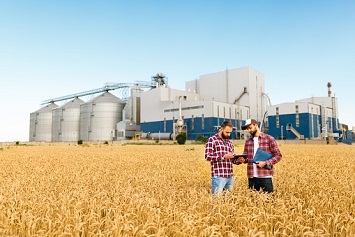In response to one frequently asked question (FAQ) on the EPA’s emergency management site, the Agency clarified when combustible agricultural dusts are subject to reporting under Section 312 of the Emergency Planning and Community Right-to-Know Act (EPCRA).
The question is a reasonable one given that determining which combustible dusts must be reported and which are exempt can be a multistep task. For example, one consideration is whether the combustible dust is also a food or food additive as defined by the Food and Drug Administration (FDA). Furthermore, under EPCRA, individual states are authorized to require Section 312 reporting for hazardous chemicals, including combustible dusts, for which no reporting is required by the EPA or for reportable substances that are present at a facility in quantities below the federal thresholds. What’s more, the Agency recommends voluntary Section 312 reporting of combustible dusts that are not subject to reporting because the on-site quantities do not reach the applicable thresholds.
Connection to Section 311
EPCRA Section 312 is linked to EPCRA Section 311. Section 311 requires facilities that have safety data sheets (SDSs) for chemicals held above certain threshold quantities to submit either copies of their SDSs or a list of these chemicals to the State Emergency Response Commission (SERC), the Tribal Emergency Response Commission (TERC), the Local Emergency Planning Committee (LEPC), and the local fire department. This is a onetime submittal.
Under Section 312, facilities covered by Section 311 must also annually submit an Emergency and Hazardous Chemical Inventory Form for the same chemicals subject to Section 311 to the LEPC, the SERC or the TERC, and the local fire department. Specifically, Section 312 reporting is required for any substance defined by the Occupational Safety and Health Administration (OSHA) as a hazardous chemical subject to OSHA’s Hazard Communication Standard (HCS) (29 CFR Section 1910.1200) when that substance is present at a facility above threshold amounts at any one time during the previous calendar year. The threshold for an extremely hazardous substance (40 CFR Part 355 Appendix A) is either 500 pounds (lb) or the threshold planning quantity (TPQ), whichever is lower. For all other hazardous chemicals, the threshold is 10,000 lb.
Tier I or Tier II
Under the federal law, either a Tier I or Tier II inventory form is used for Section 312 reporting. A competed Tier II form contains more information about the chemical than a completed Tier I form; all states now require facilities to submit on Tier II inventory forms or the state-equivalent forms.
Dust and Powered Products
The EPA was asked if EPCRA requires that facilities submit Section 312 forms for agricultural dusts or agricultural products in powdered form.
The Agency first notes that OSHA defines a “hazardous chemical” as any chemical classified as a physical or health hazard, simple asphyxiant, combustible dust, pyrophoric gas, or hazard not otherwise classified (29 CFR 1910.1200(c)). Examples of combustible dusts are available on several OSHA websites (e.g., https://www.osha.gov/dsg/combustibledust/index.html). Furthermore, OSHA lists certain agricultural dusts and agricultural products that are handled in powdered form as combustible dusts because they have the potential to explode.
If a facility handles such agricultural dusts or powders, those substances must be reported on the Tier II chemical inventory form if they equal or exceed the applicable threshold. When making determinations for both threshold purposes and for the amount of dust present for inclusion on the Tier II form (e.g., maximum amount and average amount on-site), facility owners and operators may use their best professional judgment or engineering calculations.
Voluntary Reporting
Physical hazards can exist with combustible dusts in quantities below the threshold amounts. Accordingly, the EPA encourages facilities with below-threshold quantities to voluntarily submit this information on their Tier II chemical inventory forms. Facilities voluntarily reporting combustible dust do not need to report any amounts on the Tier II form; however, they should check the Below Reporting Threshold checkbox.
Food
Regarding food, the EPA notes that substances regulated as food or a food additive by the FDA are exempted from the definition of a hazardous chemical. Facilities are encouraged to consult the following websites for FDA guidelines:
- Food Additive Status List
- Inventory of Generally Recognized as Safe (GRAS) Notices submitted to the FDA
- Inventory of Effective Food Contact Substance Notifications
Again, state Section 312 reporting requirements may exceed those of the EPA. As noted, states may have longer lists of reportable hazardous substances and lower reporting thresholds. In addition, some states require reporting of the actual amount of hazardous chemical present on-site instead of reporting the amount in ranges on the Tier II form. Owners and operators are urged to contact their states for specific reporting requirements.

